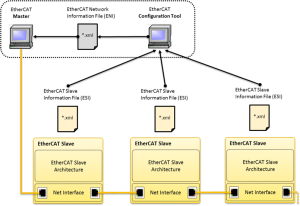ESI and ENI Files
The EtherCAT![]() ***EtherCAT is an open, high-performance Ethernet-based fieldbus system. The development goal of EtherCAT was to apply Ethernet to automation applications which require short data update times (also called cycle times) with low communication jitter (for synchronization purposes) and low hardware costs master uses the information from the ENI file to initialize and configure the EtherCAT network.
***EtherCAT is an open, high-performance Ethernet-based fieldbus system. The development goal of EtherCAT was to apply Ethernet to automation applications which require short data update times (also called cycle times) with low communication jitter (for synchronization purposes) and low hardware costs master uses the information from the ENI file to initialize and configure the EtherCAT network.
- The ESI files are provided by the vendor for each device.
- They contain information about the device functionality and its settings.
- The ESI files are used by the KAS-IDE
 "Integrated development environment"
An integrated development environment is a type of computer software that assists computer programmers in developing software.
IDEs normally consist of a source code editor, a compiler and/or interpreter, build-automation tools, and a debugger to generate the ENI file.
"Integrated development environment"
An integrated development environment is a type of computer software that assists computer programmers in developing software.
IDEs normally consist of a source code editor, a compiler and/or interpreter, build-automation tools, and a debugger to generate the ENI file. - The KAS controller’s EtherCAT master uses the ENI file for network initialization and configuration.
Figure 9-62: EtherCAT Network Architecture 1
| ENI File |
A network configuration file in XML
|
| ESI File |
A device description in XML format.
|
-
-
KAS uses ENI schema version 1.3 (May 20, 2009).
See the ETG.2100 specification at www.ethercat.org for more information.







